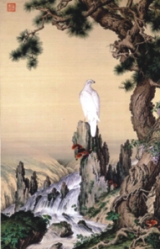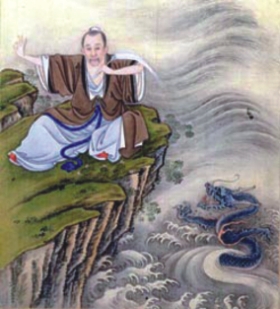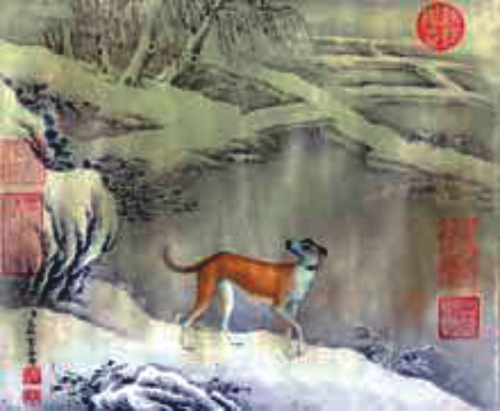|
Art
 |
Portrait of the Kangxi Emperor in Court Dress, by anonymous court artists. Late Kangxi period. Hanging scroll, colour on silk. The Palace Museum, Beijing. |
The Empire of the Arts
Tara Pepper
Rarely seen works from three Chinese dynasties go on show in London. Hu Jintao is among the first visitors.
Turn the wrong corner in the new exhibition at London's Royal Academy, "China: The Three Emperors, 1662-1795," and you could easily miss the exquisite highlight of the show. Toward the end of the exhibit, which runs until April 12, galleries filled with opulent palace furnishings and precious robes from the era of China's Ching dynasty suddenly give way to a side room containing simple ink paintings of mountains, streams and pine trees. These poetic works mark the quiet rebellion of the intelligentsia, who left or were ejected from court when the Ching replaced the Ming dynasty, and provide a poignant and personal counterpoint to the rest of the show. The delicate drawings express grief, loss and hope as well as a disdain for the new rulers that is not seen elsewhere.
As the West struggles for a deeper understanding of the rising superpower in the East, the Royal Academy's new exhibition is both timely and thought-provoking. The show, which covers the reigns of the emperors Kang-hsi, Yung Cheng and Chien-lung, consists of 400 objects mostly on loan from Beijing's Palace Museum. The majority have never been seen outside the Forbidden City, and some have never been displayed at all; few
 |
The Pine Hawk and 1723-35 by Lang Shining(Giuseppe Castiglione); Glossy Ganoderma; Hanging Scroll, colour silk. |
rooms in the Beijing museum have the climate-control technology necessary for such fragile works. And as the finishing touches were put on the show last week, a more modern expression of dissent echoed in the gallery: campaigners protesting China's human-rights record massed on sidewalks as Chinese President Hu Jintao arrived for a state visit to Buckingham Palace and talks with Tony Blair, as well as a personal tour of the show with the queen. As dusk fell, London's landmarks were bathed in red light, the backdrop to this theater of diplomatic relations. The exhibit emphasizes the emperors' connections with the West: they relied on Jesuit missionaries to supply them with clocks and astronomical instruments made in Britain, for instance. A striking painting of a white hawk by Giuseppe Castiglione melds a Chinese subject with Western perspective and use of light and shade, to dramatic effect.
 |
| Album of the Yongzheng Emperor in Costumes, The Daoist Guise Yongzheng period (1723-35) by anonymous court artists. Album leaf ink and colour on silk; Palace Museum, beijing |
The show also highlights the diverse ways in which the three emperors used art to enhance their prestige and transform themselves into omnipresent lords. "Life is a set of theatrical performances," says curator Dame Jessica Rawson, "particularly if you're a ruler." The emperors constantly assumed different roles: scholars, warriors, hunters, rulers and religious men. One album of paintings, for instance, depicts Yung Cheng (reigned 1723-1735) as a Mongolian prince, a venerated poet, a monk and a Taoist priest. Chien-lung (1736-1795) was portrayed as
the Bodhisattva Manjusri -- the embodiment of wisdom -- in a number of paintings that show him simultaneously as a monk and a world ruler. The emperors received Mongols and Tibetans with great pomp at temples they had constructed in their summer palace at Rehe, and ordered the production of exquisite ceremonial artifacts, like a gilded metal and silver stupa, or urn containing relics of the Buddha, inlaid with rubies, turquoise and lapis lazuli. Art became a powerful expression of their authority. All three rulers commissioned large-scale paintings and scrolls depicting their hunting expeditions to the north, their visits to establish governments in the south and their participation in important ceremonies such as the ritual plowing of furrows and other sacred rites at the Altar of Agriculture each spring. The emperors assiduously collected antiquities, jades and ceramics, seeking to express their command over China's heritage, as well as securing their reputation for the future. But their interest in art wasn't all about imperial power. Kang-hsi (1662-1722) spent hours learning calligraphy. Chien-lung took a particular interest in his antiquities, annotating and commenting on them. The paintings of China's dissidents express an individual spirituality and poetic vision that is easier for the West to relate to. But beyond the overwhelming splendor of courtly life, this fascinating show offers glimpses of humanity and a real passion for the arts among its emperors, too.
 |
Seven Fine Dogs; 1739-45 by Ai Kimang (Ignaz Sichelbarth); Album on Ten Leaves; colour on paper; 24.5x29.3 cm; Palace Museum, Beijing |
(c) 2005, Newsweek Inc. All rights reserved. Copyright (R) thedailystar.net 2005 |
| |
